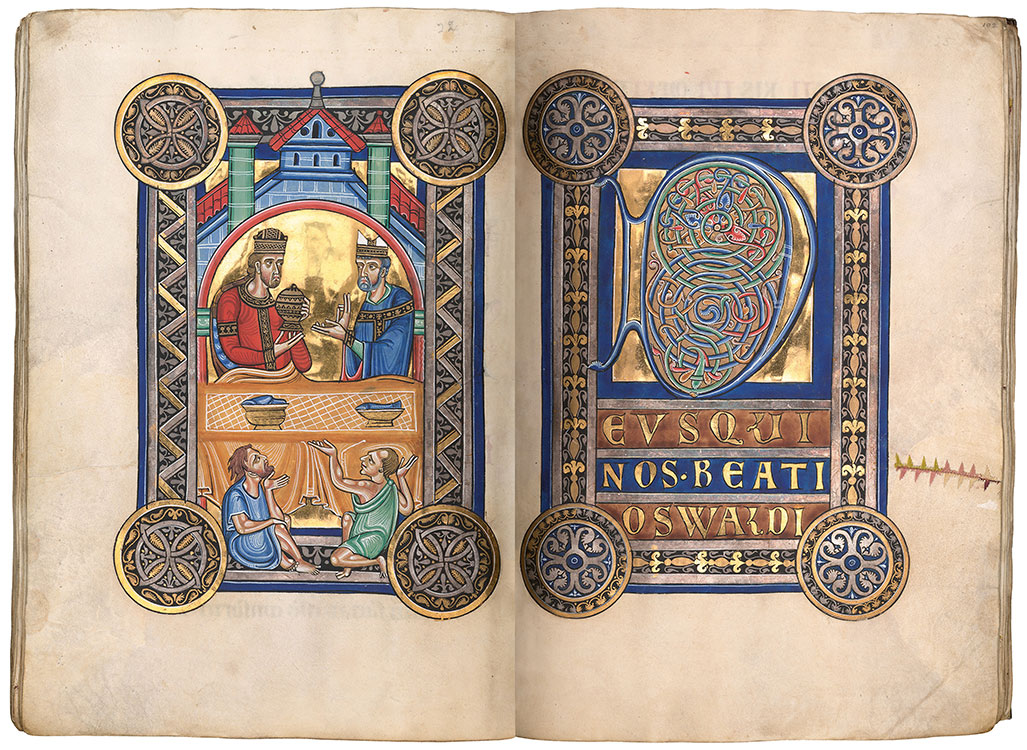
THE MONASTIC SCRIPTORIUM
In 1215, fire consumed the monastery at Weingarten. Major relics were lost, and the abbey church had to be rebuilt. In this context of renewal, Abbot Berthold engaged a professional painter—known as the Berthold Master—who illuminated a new set of liturgical books, chief among them this magnificent Mass book. The miniature for the feast day of St. Oswald, at left, depicts the saintly king of Northumbria seated next to Bishop Aidan of Lindisfarne. According to legend, Oswald gave so charitably to the poor that the bishop blessed the king’s generous hand. The hand never aged, becoming a wonder-working relic after his death. Emphasizing the miraculous qualities of Oswald’s relics, this full-page miniature promotes the cult of one of Weingarten’s patron saints. The manuscript preserves its original curtains and treasure binding.
"Berthold Sacramentary," in Latin
Illuminated by the Berthold Master
Germany, Weingarten, ca. 1215–17
The Morgan Library & Museum, MS M.710, fols. 101v–102r
Purchased by J. P. Morgan, Jr., 1926
Joshua O'Driscoll, Assistant Curator of Medieval and Renaissance Manuscripts
In the decades around 1200, pilgrims began to arrive at the Abbey of Weingarten, in Swabia, to venerate an extraordinary relic of Christ’s blood, which was donated by Judith of Flanders, the duchess of Bavaria and a great patron of the arts. Coinciding with this rise in pilgrimage, Berthold, the abbot of Weingarten, undertook an ambitious program of cultural production to reinforce the abbey’s new status as a religious center of international renown. Berthold’s leadership was tested when a catastrophic fire destroyed the monastery in 1215. Despite significant losses, the abbot was able to rededicate his church in just a few years. It is in this context of renewal and revitalization that Berthold engaged a professional painter to illuminate a new set of liturgical books for the monastery.
This magnificent mass Book represents Berthold’s most important commission. Shown here is the miniature for the feast of St Oswald, an obscure English saint who was initially not highly esteemed at Weingarten. Nevertheless, his relics formed part of Judith’s donation and Berthold made a conscious effort to raise the saint’s profile after the relics of other saints were destroyed in the fire. The use of colorful embroidered repairs, one of which you see on the margin of the right page, was part of a broader effort to make the manuscript appear older than it actually was. In a similar manner, the manuscript’s magnificent jeweled cover harks back to the age of Carolingian treasure bindings like the Lindau Gospels.
With its spectacular paintings and its range of precious materials from gold and gems to textiles and relics, the Berthold Sacramentary marks a high point of monastic book production. Moreover, as a prestigious memorial object, intimately tied to the abbey’s history and its self-image, the manuscript both celebrated and legitimized the forms of devotion so carefully promoted by Abbot Berthold.
